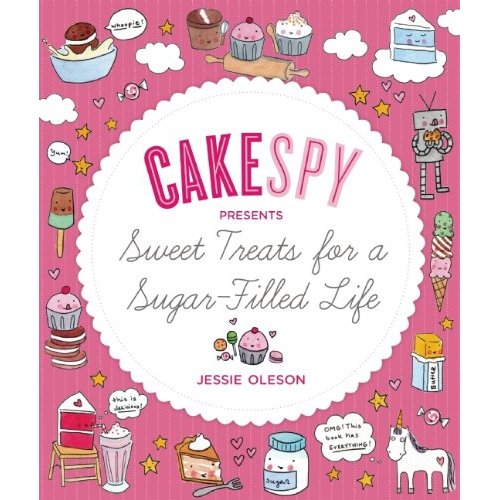
Princess Cake shown is from Miette in San Francisco; photo credit Frankie Frankeny.
Some of you may trouble yourselves mysteries of the natural universe: What is the meaning of life? If a tree falls in the woods, can anybody hear it? Why on earth is Paris Hilton famous?
But we Cake Gumshoes choose to ponder a much bigger (and more delicious) mystery: why is the princess cake green?
First things first though. For those of you not acquainted with the princess cake (or princess torte), we'd like to clarify that we're not talking about the "Princess Cake" that has a severed Barbie doll stacked atop a dome of frilly buttercream (though that one has its moments). No, we're talking about the Princesstårta, a cake which hails from Sweden, where it was invented in the 1930s by cookbook author Jenny Åkerström, who is said to have made it in honor of Sweden's three princesses at the time--Margaretha, Märtha and Astrid. While it's not as common in bakery cases as say, Red Velvet, it's not an exceedingly rare cake either--most urban areas will have at least a couple of bakeries that offer the sweet confection, which is made of alternating layers of light, airy cake, thick pastry cream, and jam, all topped with a sweet jacket of marzipan--often in a dome shape. But perhaps the most striking thing about this cake is how it's nearly always green.

Of course, there are exceptions. For instance, famed Los Angeles restaurant Scandia offered a chocolate-topped version back in the day (which, with the help of pastry chef Chris Jarchow, we made it recently; see above); some bakeries will offer an off-white or pink version. However, it seems to us that most frequently--or at least frequently enough for us to have noticed-- it's an attractive and very signature pistachio tone of green.
So what gives?
Unfortunately, this proved to be quite the challenge. Here's a summation of our epic journey to discover the truth:
First Stop: The Library
First, we hit up the library, where we consulted the serious tome of a book The Professional Pastry Chef by Bo Friberg, in which we found the following passage:
"I am slightly embarrassed to admit that I do not have a definite answer as to why is the marzipan on top of a Princess Cake traditionally colored green. This is a question I have been asked time after time, and believe me, I have tried to find out. It would at least make more sense to me if the cake were flavored with mint or pistachio. Princess Cakes are often made with other colours..."
Our buddy over at ReTorte referenced Friberg's quote too, adding that "My fancy French pastry books do not even mention Princess cake..my only theory is that, as with a lot of stuff in the pastry world, it's green because of tradition. They do A LOT of stuff just out of tradition, even though it makes no sense otherwise!"
Second Stop: The Experts
We figured if anyone would know, it would be the good Nordic population of Seattle!
Unfortunately, the mystery only deepened with a call to the
Swedish Cultural Center, where they had not a clue as to why the green-hued cake persists; however, they did point us in the direction of
Larsen's in Ballard as a spot to pick up a particularly delicious one.
While the employees at Larsen's were friendly, unfortunately they were unable to shed further light upon the cake's color. "Maybe it was the princess' favorite color," one employee muses; "maybe it was the colors of her wedding flowers" adds another, referencing the fact that it's frequently topped with a pink flower.
Last-ditch: The Internet
Just when we were beginning to despair, we found a very informative bulletin board on
chowhound.com that answered some of these questions--
one user's comments in particular were very helpful. Turns out, the confection's invention may hold the answer.

Remember how that cookbook writer invented the recipe for three princesses in the 1930s? Well, as it turns out, "it appears that Åkerström had not one, but three different princess cakes, one for each of the princesses. They were very elaborate cakes, not terribly suited to the home baker. Astrid's cake most closely resembles the princess cake in its current form."
(Cakes pictured, above). As it turns out, the article continues, "
Annika Larsson, a baker at the Grillska Konditoriet in Stockholm, is credited with combining features from the three cakes and creating the princess cake that has become a tradition--that is to say,
the green one. It appeared in Finland not long after it became popular in 1930s Sweden and has remained a traditional cake ever since, particularly for graduation and end of school year parties."
While this doesn't completely answer the question of why the cake is green, it does shed some light on the subject and leave it open to some guesswork. Perhaps when Annika was combining the best aspects of each cake, she simply preferred the green hued one as a matter of personal preference. Perhaps she had a surplus of green dye and it was done for more practical reasons.
Of course, we like to think maybe it was something truly poetic: perhaps green was a color caught on with the Swedish audience because it represented the hope of spring, like the first gentle blades of grass coming up in the cold, dark winters.
But whatever the reason, one thing is for sure: the Princess cake is certainly iconic, and we certainly feel happy whenever we see the green-hued confection turn up on our table.
P.S. Wanna try to make the Princess Cake? A fantastic recipe can be found on Tartelette, as well as some seriously beautiful pictures!
 Saturday, March 12, 2011
Saturday, March 12, 2011  CakeSpy Note: So, I have a totally sweet customer named Nicholas. He's basically the ideal customer: he comes in and buys stuff, and then tells me all about the delicious sweets he eats when he travels the world. Just looking at his pictures is bound to evoke some seriously sweet wanderlust. Here's where he's been recently:
CakeSpy Note: So, I have a totally sweet customer named Nicholas. He's basically the ideal customer: he comes in and buys stuff, and then tells me all about the delicious sweets he eats when he travels the world. Just looking at his pictures is bound to evoke some seriously sweet wanderlust. Here's where he's been recently: It used to be that it was served only in the days before lent, but now it's available from Christmas to Easter.
It used to be that it was served only in the days before lent, but now it's available from Christmas to Easter. This particular one was ranked best in the city, and it was really really good. The bun is cardamom, which has been hollowed out and then filled with a sweet almond paste, which is then topped with fresh whip cream and the top of the bun.
This particular one was ranked best in the city, and it was really really good. The bun is cardamom, which has been hollowed out and then filled with a sweet almond paste, which is then topped with fresh whip cream and the top of the bun.  Yeah, that's right. Get yourself to Stockholm! Curious to learn more? Learn more about Lux Dessert och Choklad here.
Yeah, that's right. Get yourself to Stockholm! Curious to learn more? Learn more about Lux Dessert och Choklad here. guest blog,
guest blog,  sweden
sweden 









































